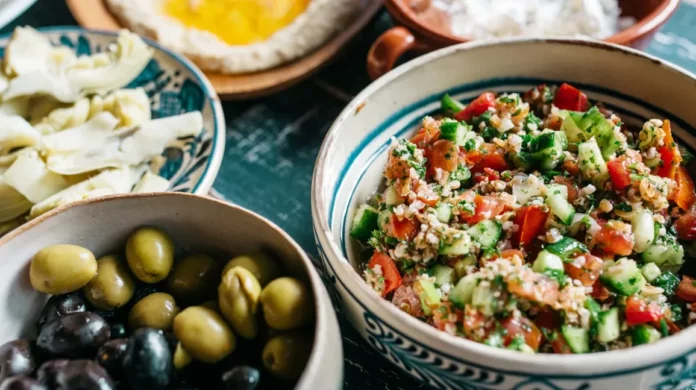Introduction
Food is not only a source of sustenance but also an integral part of our cultural identity. Different cultures have distinct culinary traditions and dietary patterns that shape the way people eat and live. In this article, we will explore the question of which culture has the healthiest food. By examining the dietary practices of several cultures known for their emphasis on wholesome ingredients and balanced nutrition, we can gain insights into the benefits of cultural diversity in promoting healthy eating.
Traditional Mediterranean Diet
The Mediterranean region, known for its picturesque coastlines and vibrant cuisine, is often hailed for having one of the healthiest food cultures in the world. The traditional Mediterranean diet is characterized by an abundance of fresh fruits and vegetables, whole grains, legumes, olive oil, nuts, and seeds. It also includes moderate amounts of fish, poultry, dairy products, and red wine. The Mediterranean diet is rich in antioxidants, healthy fats, and fiber, which have been linked to lower rates of heart disease, obesity, and certain cancers.
Japanese Cuisine
Japanese cuisine is renowned for its emphasis on fresh, seasonal ingredients, balance, and meticulous presentation. The traditional Japanese diet includes a variety of fish, seafood, tofu, vegetables, rice, and fermented foods like miso and soy sauce. The Japanese practice of “hara hachi bu,” which means eating until you are 80% full, promotes mindful eating and portion control. The Japanese diet is low in saturated fats, high in omega-3 fatty acids, and rich in antioxidants, contributing to a lower risk of heart disease and longer life expectancy.
Indian Cuisine
Indian cuisine is as diverse as its vast subcontinent, with regional variations in flavors, ingredients, and cooking techniques. Indian food incorporates a wide array of spices and herbs, such as turmeric, cumin, coriander, and ginger, which not only add flavor but also have medicinal properties. Indian cuisine offers a wealth of vegetarian and plant-based options, including lentils, legumes, vegetables, and whole grains. Ayurvedic principles, which emphasize balance and individual constitution, also influence traditional Indian diets. The variety of spices, colorful vegetables, and nutrient-rich ingredients make Indian food a healthy and flavorful choice.
Mexican Cuisine
Mexican cuisine is a fusion of ancient Mesoamerican traditions and Spanish influences. It is known for its bold flavors, vibrant colors, and the use of fresh, locally sourced ingredients. Traditional Mexican food incorporates a variety of whole grains, legumes, fresh fruits and vegetables, herbs, and spices. Corn, beans, avocados, tomatoes, and chili peppers are staple ingredients that provide a range of nutrients and antioxidants. The concept of “comida casera,” homemade meals prepared with love and care, promotes a focus on whole foods and nourishing family traditions.
Traditional African Diets
The African continent encompasses a rich tapestry of cultures and cuisines, each with its own unique flavors and culinary traditions. Traditional African diets are characterized by an abundance of plant-based foods, including fruits, vegetables, whole grains, legumes, and nuts. Lean proteins, such as fish, poultry, and occasional lean meats, are also incorporated. Communal eating is a common practice in many African cultures, promoting social connections and shared meals. The reliance on whole foods and a variety of fresh produce contributes to the health benefits associated with traditional African diets.
The Blue Zones
Blue Zones are regions of the world where people live longer and healthier lives. These regions, including Okinawa (Japan), Ikaria (Greece), Sardinia (Italy), Nicoya Peninsula (Costa Rica), and Loma Linda (California), have become renowned for their high rates of longevity. While the dietary patterns in each Blue Zone vary, commonalities include a predominantly plant-based diet rich in vegetables, legumes, whole grains, and nuts. These diets also tend to be low in processed foods and sugar, emphasizing natural, nutrient-dense ingredients.
Balancing Cultural Context and Individual Needs
While exploring cultures with healthy food traditions is enlightening, it is important to remember that healthy eating should be tailored to individual needs and preferences. Considering cultural food preferences and traditions can provide a foundation for healthy eating. However, customization based on individual dietary restrictions, allergies, and specific health goals is also crucial. Combining the best practices from various cultural diets allows for a diverse and nutritious approach to healthy eating.
Conclusion
In conclusion, numerous cultures around the world offer healthy food traditions that contribute to overall well-being. The traditional Mediterranean diet, Japanese cuisine, Indian cuisine, Mexican cuisine, traditional African diets, and the dietary patterns observed in Blue Zones all exemplify the positive impact of cultural food practices on health. Embracing cultural diversity in food choices allows us to explore new flavors, broaden our culinary horizons, and adopt healthier eating habits. By appreciating and integrating the best of different cultural diets, we can enhance our own health and celebrate the richness of global culinary heritage.


